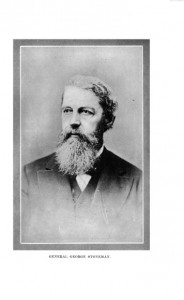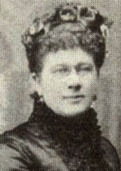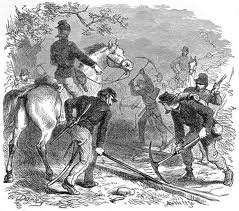Happy Belated Birthday Governor Stoneman!
George Stoneman was a Civil War general and cavalry commander, who enjoyed national celebrity before being elected California’s 15th governor in 1882.
The highest-ranking Union officer captured by the Confederates, Stoneman is immortalized in The Band’s “The Night They Drove Old Dixie Down.”
“Virgil Caine is the name and I served on the Danville train, ‘til Stoneman’s cavalry came and they tore up the tracks again….”
 Born August 8, 1822 the first of 10 children, the genial, 6’ 4” Stoneman was 57 when he ran for elective office in 1879, successfully securing a seat on California’s newly created three-member railroad commission. He argued unsuccessfully for stricter rate regulation and as governor fought – again unsuccessfully — to make Central Pacific and its successor Southern Pacific Railroad pay more than $1 million owed in state taxes.
Born August 8, 1822 the first of 10 children, the genial, 6’ 4” Stoneman was 57 when he ran for elective office in 1879, successfully securing a seat on California’s newly created three-member railroad commission. He argued unsuccessfully for stricter rate regulation and as governor fought – again unsuccessfully — to make Central Pacific and its successor Southern Pacific Railroad pay more than $1 million owed in state taxes.
“It was to be a long time before another governor fought the railroad corporations. That (Stoneman) did not make any progress was not his fault, for he was fighting against superior and well-entrenched forces,” write H. Brett Melendy and Benjamin Gilbert in The Governors of California.
“During his term, many advances were made in creating state agencies for the welfare and protection of the average citizen. Insofar as he was able to do so, he carried out his creed of a government for all the people. Stoneman’s administration was the brightest period in the history of the office of governor during the last three decades of the 19th Century,” Melendy and Gilbert conclude.
Two new state hospitals were OK’d by Stoneman and a home for the blind. The state’s first forestry board as well.
THE CIVIL WAR
At the war’s outbreak, the sad-eyed Stoneman was in command of Fort Brown, Texas. Refusing to surrender to the newly formed Confederate government, Stoneman evacuated the fort and sailed north with most of his command.
Promoted to major, Stoneman served on the staff of George McClellan with whom he graduated from West Point in 1846. Thomas “Stonewall” Jackson was Stoneman’s roommate at the Army academy.
After West Point, Stoneman was assigned to the Mormon Battalion, aimed at enlisting Mormons to help support the occupation of California.
The battalion marched form Iowa to California in the winter of 1846 with Stoneman as quartermaster, blazing new trails for settlers . Upon arrival, Stoneman fell in love with California.
Afterwards, he guarded surveys in the Sierra Nevada looking for the best railway routes.
When McClellan was given command of the Army of the Potomac, Stoneman became a Brigadier General of Volunteers and Chief of Cavalry.
Rather than letting cavalry rove unfettered to slice through enemy forces, McClellan assigned small numbers to infantry brigades, a move that contributed to the Union’s failure in the Peninsula Campaign of 1862, an amphibious assault aimed at capturing Richmond.
Afterwards, Stoneman was given command of an infantry division, roughly 12,000 soldiers.
He became a major general in 1863 and was placed in charge of a reorganized Cavalry Corps – three divisions of horse — under the new commander of the Army of the Potomac, Joseph Hooker.
Not an ideal condition for a cavalryman, Stoneman suffered from severe hemorrhoids, which would plague him his entire life.
At the battle of Chancellorsville, Stoneman was charged with slicing behind the Confederate line, destroying railway and supply trains to distract Gen. Robert E. Lee from Hooker’s main assault.
Known as “Stoneman’s Raid,” the effort bogged down when rainy conditions hampered travel and troop effectiveness. Although some Confederate troops were diverted from the front, the Union lost the battle.
Hooker blamed Stoneman, effectively relieving him of command by sending him to Washington D.C. for treatment of his hemorrhoids.
Alfred Pleasonton, for whom the city of Pleasanton is named, replaced Stoneman.
The new Cavalry Bureau became Stoneman’s desk-riding command in the nation’s capitol.
Eager to return to the field, Stoneman got his wish through friend and fellow New Yorker John Schofield who prosecuted the war in Ohio. Stoneman became head of the Army of Ohio’s Cavalry Corps.
He and his aide-de-camp were captured outside of Macon Georgia in a raid designed by Stoneman to liberate the notorious Andersonville prison camp.
Stoneman was a prisoner for three months.
Gen. William Tecumseh Sherman arranged for Stoneman’s release in exchange for a captured Confederate general, which soured Sherman’s assessment of the cavalry general’s capabilities.
Stoneman burnished his reputation through raids late in the war into Virginia and North Carolina.
In March 1865, Stoneman, at the head of about 4,000 cavalrymen, tore up miles of tracks, burned bridges, destroyed tons of Confederate supplies and assisted in the capture of Jefferson Davis.
Ulysses S. Grant, the Union commander, believed Stoneman’s raid and another like it in Alabama, would “leave nothing for the rebellion to stand upon.”
Lee surrendered to Grant on Palm Sunday 1865.
POSTWAR LIFE
After the war, Stoneman became commander of the Department of the Tennessee, which oversaw Union operations around the Tennessee River.
While he administered occupied Memphis, riots broke out over the presence of African-American federal troops. Forty-six blacks were killed.
Stoneman was criticized for inaction but exonerated by a congressional committee investigating the incident.
He soured on the policies of Reconstruction and became a Democrat in 1866.
In 1870, he took command of the Department of Arizona. Stoneman was charged with reducing its budget from $3 million to $1 million resulting in civilians losing their jobs and government contracts being curtailed.
In part because of the budget cuts, he earned the ire of the territory’s white residents. His relentless assault on Apaches ran afoul of federal policy.
“Stoneman was accused of spending too much time in the details of establishing new posts and the improvement of old ones, the building of roads, etc. Consequently, the ‘red tape’ business of military circles received a liberal share of abuse,” wrote Thomas Edwin Farish in History of Arizona, Volume VIII, published in 1918.
“While this popular outcry against the general in command of Arizona was going on in the territory, in the East a sympathetic feeling was gaining ground that demanded the use of pacific measures with the Indians and Stoneman was censured for being too severe in attacking all Apaches for the offenses of the few.
“However, it must be said that much of his policy was good and finally led to a solution of the Indian problems. (Stoneman) believed by furnishing rations and blankets to a few friendly Indians, it would induce others to come in and so gradually lessen the work of subduing them. He believed also in placing them upon reservations.”
Stoneman was relieved in 1871 amid charges by some Arizonans that he was actually living near Los Angeles.
His love affair with California led to the purchase of a 400-acre ranch he called Los Robles in the San Gabriel Valley. It was at his ranch that he turned over his Arizona command.
For the next several years, Stoneman and his wife, Mary, whom he married in 1861, devoted themselves to ranching.
The former Mary Hardisty was from a prominent Baltimore family that considered themselves Southerners.
She called her husband “Stony.” She didn’t enjoy campaigning and — known for a penchant to speak her mind — she wrote that seeing her husband in politics made her “sick.”
As First Lady, she was a fixture in Sacramento and San Francisco society. She was said to be a good dancer.
 The couple had four children, two sons and two daughters.
The couple had four children, two sons and two daughters.
In 1876, Gov. William Irwin named Stoneman one of the state’s three transportation commissioners, a $3,000-per-year job he held until 1878 when the commission was dissolved in favor of a single commissioner.
His first elective office was railroad commissioner where he accomplished little since the other two commissioners were tools of the railroad. But his opposition to the railroads won him statewide attention.
George Hearst, owner of the San Francisco Examiner, sought the Democratic nomination for governor in 1882. Stoneman bested him on the fourteenth ballot, thanks to strong support from farmers suffering from the railroad’s high freight prices.
The centerpiece of the campaign was the railroads and their stranglehold on the state economy.
Stoneman was criticized for being a recent arrival to the state and, therefore, ignorant of its problems.
The Daily Alta, as quoted in Melendy and Gilbert, says Stoneman was a poor speaker whose “heart is all right but his mouth is as a scatter gun.”
Out of the four candidates, Stoneman prevailed with 40 percent of the vote.
IN THE CORNER OFFICE
“The people are the sovereigns and we are the servants,” Stoneman said in his January 10, 1883 inaugural speech.
His primary focus in the speech was the railroads.
“Regulation of fares and freights is the great living issue of the day and no postponement of its solution to the future time will prove satisfactory either to the people of this state or the Union.”
He also expressed thanks for Congress giving the Pacific Coast “partial relief from the much-deplored evil of Chinese immigration.”
And like so many governors before and after him, Stoneman called for a reduction in state spending.
“It shall be my constant aim and endeavor, during my term of office, to make economy in the expenditure of the public moneys and in maintaining the public institutions the principal features of this administration,” Stoneman said, concluding:
“To lighten the burdens of taxation, to reduce the expenses to the lowest possible standard, to allow the largest personal liberty consistent with the general welfare, not to govern except where government is necessary, to administer the law evenly and impartially on all classes and interests—these are my ideas of the requirements of the day.”
Lawmakers during the 1883 session paid little attention to Stoneman’s inaugural proposals. They did, however, create the Bureau of Labor Statistics, the forerunner of the Department of Industrial Relations.
At Gov. Jerry Brown’s suggestion, lawmakers this year approved a reorganization plan eliminating the bureau and placing its functions in another division of the department.
To Stoneman’s irritation, the railroad commission had yet to act on fare and rate regulation by November.
In March 1884, a now exasperated Stoneman called a special session of the Legislature on railroads. He said the railroad commission had failed in its mission and called for the ouster of the current commissioners, proposing a new way of electing their successors.
Maximum passenger and freight fares should be set by constitutional amendment, he said.
Anti-monopoly lawmakers, who held a comfortable majority in the Assembly, had already sought simplification of Central Pacific’s 282-page rate schedule.
“The Legislature, (Stoneman) suggested, should impose an income tax on the company’s gross receipts, proportioned in such a manner that, combined with (a change in) property assessment, it would ‘at least’ equal the taxes and penalties currently under dispute,” writes R. Hal Williams in The Democratic Party and California Politics, 1880-1896.
Since the railroad hadn’t objected to such actions previously, Stoneman told lawmakers with deep irony, “I apprehend you will experience no opposition from that source.”
In closing he said:
“It is claimed that railroad corporations have materially assisted in the development of the state and for that reason we should not interfere with them by legal enactments. Concede all that is claimed for them, it does not follow that they should be allowed to exercise unrestrained power and oppress our people.”
Most of Stoneman’s agenda easily passed the Assembly where 61 seats were filled with anti-monopoly Democrats.
But 13 conservative Democrats in the Senate joined with Republicans, blocking or watering down the proposals. When the special session adjourned May 13 the only bill passed by both houses appropriated $80,000 to cover the expenses of the session.
“Measured by its results, it is the worst legislative abortion the state has ever produced,” wrote the San Francisco Chronicle.
The Chronicle was not a fan of Stoneman finding him “apathetic, weak and vacillating,” according to Melendy and Gilbert.
In his first biennial address to the Legislature Stoneman didn’t dwell on the failure of the special session. The grape grower did call for increased powers for viticulture commissioners to foster more grape cultivation.
Stoneman concluded by telling lawmakers that the people of California had paid $2.1 million in interest on bonds used to help construct his predecessor Leland Stanford’s Central Pacific Railroad but the railroad had reneged on its pledge to, in return, provide free transport of lunatics, prison inmates, public messengers and materials for construction of the state Capitol.
To prevent overcrowding in the state’s asylums, Stoneman authorized creation of the California Home for the Care and Training of Feeble-Minded Children in Santa Clara County and the California Hospital for the Chronic Insane at Agnew.
Also created was the Industrial Home for Mechanical Trades of the Adult Blind.
On July 17, Stoneman’s ranch burned to the ground. His papers, Civil War mementos and most personal possessions were lost.
Stoneman’s supporters said the governor’s political enemies set the fire.
The insurance had lapsed so he couldn’t rebuild, a heavy blow to his wife.
He tried to find a compromise on the thorny issue of irrigation, which he and his predecessors viewed as essential to maintaining the state’s agricultural success.
At the request of 89 lawmakers, Stoneman called a special session in 1886 to deal with the issue. He received the same legislative cold shoulder as the 1884 railroad special session.
Democrats rejected Stoneman as a candidate for re-election in 1886.
AFTER THE GOVERNSHIP
 Stoneman returned to his ranch and tried for several years to make a go of it but couldn’t.
Stoneman returned to his ranch and tried for several years to make a go of it but couldn’t.
He and his wife separated over an alleged affair, which Mary denied. She moved to Brookline Massachusetts to live with one of their daughters and died in 1915.
Ruined financially and in poor health, Stoneman moved in 1891 to Albany New York to live with a sister.
He had surgery for his hemorrhoids in New York City then moved to the home of another sister in Buffalo.
He suffered a stroke in April 1894 and never recovered, dying September 5, 1894.
At the funeral his pallbearers were all civilians and neither of his sons attended.
He is buried in the Stoneman family plot in the Bentley Cemetery in Lakewood New York.
-30-
Filed under: California History
- Capitol Cliches (16)
- Conversational Currency (3)
- Great Moments in Capitol History (4)
- News (1,288)
- Budget and Economy (383)
- California History (139)
- Demographics (11)
- Fundraising (74)
- Governor (122)
- Legislature/Legislation (270)
- Politics (173)
- State Agencies (38)
- Opinionation (36)
- Overheard (246)
- Today's Latin Lesson (45)
- Restaurant Raconteur (21)
- Spotlight (110)
- Trip to Tokyo (8)
- Venting (184)
- Warren Buffett (43)
- Welcome (1)
- Words That Aren't Heard in Committee Enough (11)




Sounds like “lunatics” we’re a big issue in those days. Why didn’t his kids go to the funeral?
Comment by DCurtin — 8.10.2012 @ 10:15 pm